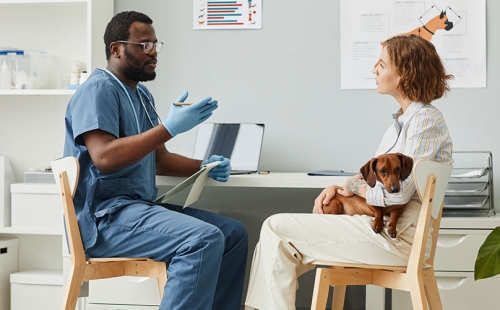Communicating the Value of Diagnostic Tests to Veterinary Clients

Diagnostic tests are vital for understanding a pet’s health and providing a high standard of care. Whether establishing a routine wellness baseline or investigating illness, diagnostics tests provide information veterinarians need to guide patient care and select appropriate treatments. However, pet owners may not recognize the value of diagnostics, and opt to skip this important part of their pet’s health plan.
Clients decline diagnostics for many reasons, including a failure of the veterinary team to adequately educate them about the tests’ necessity and benefits. Effective communication is key to helping clients make informed decisions about their companion animal care. Use the following communication tips for various clinical situations.
Diagnostics for routine veterinary care
Prevention is the foundation of animal healthcare. Routine diagnostic tests help veterinarians identify health issues early, facilitating better long-term pet care and well-being. Prioritize educating clients at each wellness consultation about recommended diagnostic tests and—most importantly—why you recommend them. Talk about common health problems you find in pets who appear healthy and how annual “normal” blood work helps you diagnose problems later in life.
Diagnostics for acute veterinary care
Pet owners are often overwhelmed when presenting a sick pet, so communication during these visits can take some finesse. Take your time and speak in clear, calm statements to help the client understand what you suspect and why you need a test to confirm the diagnosis. Sharing your differentials and how diagnostics would impact treatment for those problems ensures the client feels involved, which can help them make informed decisions.
Addressing client concerns
Pet owners may forgo tests because they’d rather allocate funds to other services or non-pet expenses that seem more urgent. Others hesitate for fear of bad news or because they think treatment would be too expensive or stressful for the pet.
Address concerns about diagnostics with education, clear communication, and the following:
- Transparent pricing — Always provide estimates and explain how the costs relate to the pet’s well-being. Explain why each test is necessary and offer alternative testing options in a step-wise fashion.
- Empathy — Acknowledge and validate the client’s emotions, and reassure them of your shared goal to prioritize their furry pal’s health.
- Payment options — Discuss payment options, such as repayment plans and dedicated pet credit cards, early and often.
Additional tips for talking to clients about diagnostics
Here are other strategies that can help when talking to clients:
- Use communication tools — Use handouts and visual aids to explain complex concepts in the exam room. Leverage social media or a veterinary practice blog to educate clients where they most frequently seek information and advice.
- Lean on team members — Train everyone on the importance of diagnostic testing and how to relay that message to clients. Clients must hear information several times before it sinks in, so provide a unified, consistent message at multiple visit touchpoints.
- Explain results — Client communication doesn’t end when the pet leaves the veterinary practice. Follow-ups allow team members to share test results, reinforce concepts discussed during the consultation, and provide a safe space for clients to ask pet health questions. These interactions help build trust.
Clients may struggle to understand the value of diagnostic testing or encounter a barrier to saying “yes” to what’s best for their pet’s health. Knowing how to talk about testing and focusing on education and empathy help veterinary teams create happier clients and healthier pets.
Want more content like this?
Sign up for The Connected Practice Newsletter




